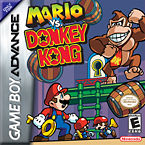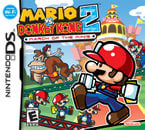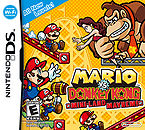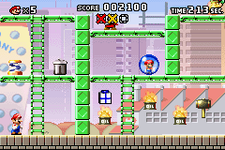Mario vs. Donkey Kong (series)
This article is under construction. Therefore, please excuse its informal appearance while it is being worked on. We hope to have it completed as soon as possible.
Template:Series-infobox Mario vs. Donkey Kong (known as Mario and Donkey Kong in Mario and Donkey Kong: Minis on the Move) is a sub-series of the Mario series and the Donkey Kong series. The first game, Mario vs. Donkey Kong, was heavily inspired by the Game Boy follow up to the original Donkey Kong game, and was initially planned as Donkey Kong Plus. This series features a comeback of Pauline and Donkey Kong's rivalry with Mario.
Games
It has been requested that this article be rewritten and expanded to include more information.
| Title, original release and system | Synopsis and Ratings |
|---|---|
| Mario vs. Donkey Kong
|
Mario vs. Donkey Kong is the first game of the series. The game was created for the Game Boy Advance, as the game brings back Mario and Donkey Kong's rivalry from the Mario series' first game, Donkey Kong. But instead of fighting over Pauline, they fight over the Mini Marios instead, at the end of the game, Mario gives Donkey Kong a Mini Mario as a gift. |
| Template:Releasedate Game Boy Advance | (Ratings unavailable) |
| Mario vs. Donkey Kong 2: March of the Minis
|
Mario vs. Donkey Kong 2: March of the Minis is a platform game and sequel to Mario vs. Donkey Kong. The game is for the Nintendo DS. It was released on September 25, 2006. Instead of the first game's plot of the player using Mario and rescuing the Minis, Mario and the Minis now fight to rescue Pauline, as the player go through stages, guiding the Minis to the end of the level. |
| Template:Releasedate Nintendo DS | (Ratings unavailable) |
| Mario vs. Donkey Kong: Minis March Again!
|
Mario vs. Donkey Kong: Minis March Again! is the third installment in the series. The game is for the Nintendo DSi's DSiWare. Similar to the second game in the series, Mario once again sends the Mini Marios to rescue Pauline from Donkey Kong. |
| Template:Releasedate Nintendo DSi | (Ratings unavailable) |
| Mario vs. Donkey Kong: Mini-Land Mayhem!
|
Mario vs. Donkey Kong: Mini-Land Mayhem! is the fourth installment in the series and the second for the Nintendo DS. As in the two previous games, Mario and the Minis set out once again to rescue Pauline from Donkey Kong. |
| Template:Releasedate Nintendo DS | (Ratings unavailable) |
| Mario and Donkey Kong: Minis on the Move
|
Mario and Donkey Kong: Minis on the Move is a Nintendo 3DS Nintendo eShop game, as part of the Mario vs. Donkey Kong series. In this game, Donkey Kong and Pauline join to run a carnival. This is also the first three-dimensional game in the series, but its gameplay is similar to the past games'. In this game, the player must place falling tiles on a field and guide Mario to the goal. Besides the main game, three extra modes and four minigames are available. |
| Template:Releasedate Nintendo 3DS | (Ratings unavailable) |
| Mario vs. Donkey Kong: Tipping Stars
File:Mario-dk-tipping-stars-boxart-eu-wii-u.jpg |
Mario vs. Donkey Kong: Tipping Stars is a Wii U and Nintendo 3DS game in the Mario vs. Donkey Kong series. It is based on the Mario vs. Donkey Kong demo shown at GDC 2014. The gameplay is the same as in Mario vs. Donkey Kong: Mini-land Mayhem. Several new features are added in the game, including Mini Luigis and the Workshop Store, where players can buy new parts for the Level Editor. Levels can be be shared online and commented on through Miiverse. |
| Template:Releasedate Nintendo 3DS/Wii U | (Ratings unavailable) |
Gameplay
This article is under construction. Therefore, please excuse its informal appearance while it is being worked on. We hope to have it completed as soon as possible.
Mario vs. Donkey Kong
Each of the games six worlds is divided into eight levels. For the first six levels within each world, Mario must find a key and open up a door to the second half of the level, which is a checkpoint. There, Mario will find the toy that Donkey Kong dropped. If Mario is defeated in the second half of the level, his points reset to zero. At the beginning of each level, there is short sequence showing what Mario needs to do or what he may face before playing the level. This short sequence also explains what moves Mario needs to use to complete the level, showing some button combinations.
Unlike other Mario games, when Mario takes a hit, he loses a life. He can also lose a life from getting squished and falling on from a great height and landing on his head. If the fall is not big enough, Mario may get stunned on his back instead. There is also a time limit, which is similar to the traditional Super Mario Bros. games; if the time limit is low, an alarm plays and Mario panics. If the time limit runs out, Mario loses a life. Also unlike other Mario games, however, Mario has more moves he can use, such as jump, handstand, and and even higher jump. To defeat enemies, Mario must pick up objects and throw them at enemies, reminiscent of Super Mario Bros. 2. Throughout the level, there are some collectibles Mario can collect. Three are pivotal in earning a high score, which are different colored presents. Earning a high enough score, beating the default socre, earns a star for that level. The stars later are used to unlock Expert levels.
Once Mario completes a level and collects enough presents, he can play a short minigame to earn extra lives. One present may have a 1-up, one may have a 3-up or 5-up, and one present may have nothing; this is shown at the beginning of the minigame. One minigame is stopping a scrolling arrow on top of the desired present while the other has Mario swapping presents so Donkey Kong's fist squashes an undesired present.
The seventh level in each world is a Mini-Mario level. Mario leads the six Mini-Mario toys he collected back to their toy chest; however, he must make sure they avoid obstacles along the way. This leads into a battle with Donkey Kong, with each Mini-Mario saved becoming a "hit point". For example, if Mario saves all six of the Mini-Mario toys, he'll be able to be hit six times by Donkey Kong before losing a life. If the player fails to defeat Donkey Kong and chooses to replay the fight without doing the Mini-Mario level, Mario will start the fight with four hit points.
After Mario has beaten the six worlds and defeated Donkey Kong, six "Plus" Worlds are unlocked, numbered 1+, 2+, and so on. There are seven stages in each Plus Worlds, and there are no Mini-Mario levels. Mario must get to a Mini-Mario holding a key and lead it to the exit doorway. There is only one part per level in the Plus Worlds, and they are designed to be more difficult than the main worlds. There are still Donkey Kong boss levels in the Plus Worlds.
After beating all of the Plus Worlds, Mario fights Donkey Kong for the final time. If the player found all of the remaining presents in replay mode, the "Expert" levels will unlock; instead of completing them one at a time, the player must beat the game's default high scores (from the "Main" and "Plus" levels) to progressively unlock the levels.
The Japanese version of the game features e-Reader support and had space for 12 levels, but only 6 cards were released[1][2].
Controls
 - Jumps
- Jumps - Picks up item
- Picks up item - Moves Mario
- Moves Mario /
/ - Selects between worlds
- Selects between worlds- Pauses and continues game.
Mario's moves
- Jump (
 )
) - Handstand (Down
 +
+  )
) - Handstand jump (
 while handstanding)
while handstanding) - Double handstand jump (
 after touching the ground from handstand jump)
after touching the ground from handstand jump) - Backflip (while facing right) (Left
 +
+  )
)
Items and Features
This article is under construction. Therefore, please excuse its informal appearance while it is being worked on. We hope to have it completed as soon as possible.
Mario vs. Donkey Kong
| Item | About |
|---|---|
| Keys are found in the first half of every regular level of the game. They must be taken to locked doors in order to open the second half. | |
| Mini Marios are the objective of the second half of the normal levels, where they must be rescued from orbs. They follow Mario in Mini Mario levels. | |
| File:MvsDK 1-UP.gif1-Up Mushroom | 1-Up Mushrooms give Mario an extra life. |
| Switches are found in three versions: red, yellow and blue. As the main effect, the switch that is active makes platforms, blocks and ladders of the same color available to use. | |
| Springs help Mario to jump higher. | |
| Conveyor Belts appear in mass in some levels. They are used to transport keys and to help Mario through narrow areas. Their direction can be changed with a switch. | |
| Donut Lifts are platforms that fall down if Mario stays too long on them. | |
| Elevators are found moving on lines. Their directions can be changed with a switch. | |
| Garbage Cans can be carried and thrown by Mario. | |
| Hammers are found floating on platforms. Mario can use them to defeat enemies, such as the Oil. The can be thrown upwards and grabbed again while in the air. | |
| Presents are found in red, yellow and blue variations. They are used to a bonus game in the end of a level, as well as opening the Plus Worlds. | |
| The letters T-O-Y are found in Mini Mario levels. They must be collected by Mini Marios to open the Toy Box. | |
| Toy Boxes are the goal of the Mini Mario levels. If the letters T-O-Y are collected, it opens and allows Mario to drop off his Mini-Marios. |
Mario vs. Donkey Kong 2: March of the Minis
This article is under construction. Therefore, please excuse its informal appearance while it is being worked on. We hope to have it completed as soon as possible.
| Item | About |
|---|---|
| Coins are used to raise the score, collecting 100 gets the player a M-Token. | |
| File:Large Coin.PNG10 Gold Coin | 10 Gold Coins are used to increase the score, but are worth 10 normal coins. |
| Cards are collectible items with a picture of Mini Mario and a letter on the back of them. There are 9 cards per world. | |
| Doors are the goal of the levels. If all the Mini Marios make it to the door the level is won. | |
| Hammer | Hammers are found floating in some levels. Hammers allow the Mini Marios to defeat enemies. |
| ? Block | ? Blocks contain items. |
| A Item that comes out of a ? Block. Turns Mini Mario into Fire Mini Mario, which allows him to hurl fireballs within a limited time to stun or defeat enemies. | |
| File:PinkBlock1.pngFile:PinkBlock2.gifFile:PinkBlock3.pngPink Block | Pink Blocks are objects that are used as bridges between the corresponding bracket. Pink Blocks can be collected and placed within a level. |
| Objects used to fling Mini Marios to higher places. | |
| Blue Spring | Objects used to fling Mini Marios to higher places, but also flings them forwards at the same time. |
| Conveyor | Conveyers are objects that move in one direction, but can be reversed using a button. Mini Marios can't go the opposite direction because the conveyer belt moves faster than the Mini. |
| Elevator | Elevaters are platforms on poles that move up and down. Once the direction of the elevator is selected it can't be changet untill the elevator reaches a floor. A elevator can hold up to 2 Mini Marios. |
| Color Switches are switches that open gates with the same color, while closing gates that have different colors. There are 3 colors of Color Switches. | |
| Warp Pipe | Warp pipes are pipes that warp Mini Marios that enter it to a different part of the level. |
| Rotate Pipe | |
| Water Valve | |
| Magnetic Block | Magnetic Blocks are blocks that Mini Marios can walk on any direction even upside down. Magnetic Blocks can be collected and placed within a level.\ |
| Swing Bar | Swing Bars are objects that can be used to cross gaps. Swing bars can also be used to launch Mini Marios upward as well. |
| Rotating Magnet Stick | |
| Donut Block | A block that falls after being walked on by Mini Marios. |
| Moving Platform | |
| Balance Beam | |
| File:Red Block.PNGFire Block | Fire Blocks are blocks that can burn wood. |
| File:Black Block.PNGBomb Block | Bomb Blocks are blocks that can destroy breakable blocks. |
Enemies
Mario vs. Donkey Kong
| Enemy | About |
|---|---|
| Bats are enemies that, once released, fly horizontally through the stage. If they touch Mario, they latch on to him, causing him to fall from the rope he is climbing. | |
| Black Shy Guys appear in Twilight City. They attack by throwing wrenches at Mario. | |
| Blowtorch Guys are found in Fire Mountain. Besides walking from side to side, they also blow fire that can harm Mario. | |
| Bob-Ombs are dropped by some dispensers. They fuse up when Mario is near and explode moments later. | |
| Boos appear in Spooky House. They chase Mario while he is not looking at them, and cower while being watched. | |
| File:Brickman.PNGBrick Monster | Brick Monsters are placed on platforms. They throw three lines of bricks under them, forcing Mario to handstand to avoid being hit. |
| Candles appear in Spooky House, where they have the ability float up and down. If Mario touches one, he gets burnt and loses an extra life. | |
| Cannons tilt up and down, shooting cannonballs. | |
| Falling Spikes fall from ceilings when Mario gets near them. They can also get stuck on the ground, and turn into platforms to the player. | |
| Fires walk from side to side on an area. They burn Mario once they touch him. | |
| Fire Piranha Plants are found stationary on platforms, usually near ropes. They spit fireballs to harm Mario. | |
| Garbage Cans look exactly like the items of the same name. They reveal themselves if Mario gets near and start walking. Mario can grab and throw them as ordinary Garbage Cans. | |
| Mini Ninjis jump up and down, similarly to regular Ninjis. This can help Mario to reach higher areas. | |
| Simple enemies that move side to side continuously. | |
| Monchees are mechanical monkeys with long tails that hang below the platforms they are on. Mario can use these tails as ropes without getting harmed. However, he still loses an extra life if he touches a Monchee's body. | |
| Nitpickers are small birds that float horizontally once they leave their nests. They also drop polka-dotted eggs at Mario. | |
| Oil is found in cans with "OIL" written on their sides and fire coming out of them. They move up and down and burn Mario if he touches them. | |
| Podoboos are found jumping out from lava. | |
| Polterguys move from side to side. There are three variations of this species: blue, red and yellow. If a switch of their respective color is pressed, they turn into stationary blocks. | |
| RamRams are found in jungle levels. Despite being enemies, they are used as platforms a few times. They can only be defeated by fruit. | |
| Sir Shovalots are firstly seen walking on platforms. But once they spot Mario, they use their front surfaces to shove him. This can be harmful when Mario touches a wall, but it also helps him to go through narrow places. | |
| Sleeping Spear Guys are firstly seen sleeping, hence their name. Once Mario gets near them, they wake up and start running after him. The back to sleep if they touch a platform edge. | |
| Snapjaws are seen climbing ropes in forest levels. They can be defeated by fruit only. | |
| Spark | |
| Thwimps jump from side to side, trying to crush Mario. They are invincible. | |
| Thwomps watch the ground and try to crush Mario if he walks under them. Switch-controlled blocks can be used to prevent them from reaching the player. If Mario touches them in any kind, including standing on top of them, he will lose a life. | |
| Thwomp Blocks fall from the ceiling, just like Thwomps. However, they keep falling even if Mario is not near. They can be used as platforms. | |
| Donkey Kong is the only boss of the game, fought in every world. In each of his fights, he attacks Mario in a different manner. |
Mario vs. Donkey Kong 2: March of the Minis
This article is under construction. Therefore, please excuse its informal appearance while it is being worked on. We hope to have it completed as soon as possible.
| Enemy | About |
|---|---|
| Bloopers at first appear to be statonary decorations but if a Mini Mario comes close enough, they will jump and hover for a few seconds allowing the Mini to pass. |
Trivia
- All games in the series were initially released outside Japan, usually in North America before any other regions.
- All of the handheld games can be played on the 3DS, as the first game can be played in the Ambassodor Program, the next two are DS games, the DSi one can be system transferred and bought on the eShop, and the fifth and sixth are eShop exclusives.





